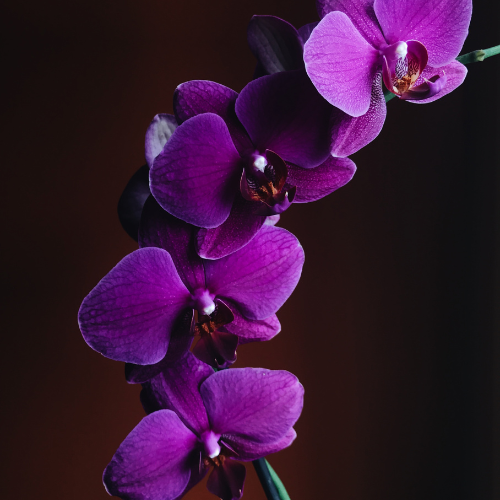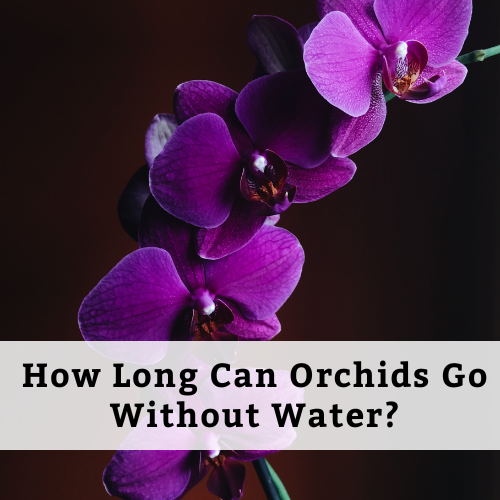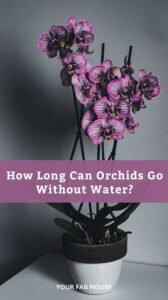How Long Can Orchids Go Without Water?
Caring for orchids can be a rewarding and fulfilling experience. These beautiful plants require proper attention and care to thrive, and regular watering is one of the most critical aspects of their care. The key to successfully watering orchids is to provide enough water to keep the roots moist but not so much that they become waterlogged.
It’s important to use a well-draining potting mix and to water the orchid thoroughly, allowing the excess water to drain away. The watering frequency will depend on the type of orchid and the environment in which it’s growing, but generally, orchids should be watered once a week or when the potting mix begins to dry out. With proper watering and care, orchids can bloom for several months, bringing joy and beauty to any space.
During the winter, it is usually recommended to water an orchid once a week, whereas, during warmer and drier weather, it is advisable to water it twice a week. Going without water for more than two to three weeks can harm an orchid, leading to its gradual deterioration and eventual death. Therefore, it is important to ensure that orchids receive adequate water and cannot remain dehydrated for extended periods.
What is so special about orchids?

Orchids are a unique and fascinating group of flowering plants that have captivated people’s attention for centuries. They are known for their striking beauty, incredible diversity, and fascinating adaptations. There are over 25,000 known species of orchids, making them one of the world’s largest families of flowering plants.
One of the most remarkable features of orchids is their flowers. They come in an astonishing variety of shapes, sizes, and colors, ranging from simple and elegant to complex and flamboyant. Orchids have evolved an incredible array of adaptations to attract pollinators, from mimicry to alluring fragrances, and even the ability to mimic female insects to attract males for mating.
Another aspect that makes orchids so special is their cultural and historical significance. Orchids have been cultivated for centuries, and many cultures around the world have developed intricate traditions and rituals surrounding these plants. In many cultures, orchids have been used in traditional medicine, as a source of food, and even as a symbol of love and fertility.
Finally, orchids are also significant for their ecological importance. They play a crucial role in many ecosystems as food sources for insects and other animals, and they also help regulate the carbon and water cycles in many environments.
Overall, orchids are special plants that offer a unique combination of beauty, diversity, and ecological significance, making them an object of fascination for botanists, horticulturists, and nature enthusiasts alike.
How Long Can Orchids Go Without Water?
The length of time that orchids can go without water depends on various factors such as the type of orchid, the growing conditions, and the size of the pot. Orchids can typically survive for several days or even a week without water. However, it’s essential to note that prolonged periods of drought can harm orchids and lead to permanent damage or even death.
Some orchids, such as those that are epiphytes or air plants, can tolerate longer periods of dryness, as they absorb moisture from the air around them. Still, most orchids require consistent watering to thrive. As a rule of thumb, it’s best to avoid letting the potting mix completely dry out and water the orchid regularly to keep it healthy and happy.
While it’s true that some types of orchids can go without water for two to three weeks, it’s important to understand that this is not the ideal condition for their growth and development. Orchids have adapted to survive in a wide range of conditions, including periods of drought, but they still require regular watering to thrive. The ability of orchids to survive for extended periods without water depends on several factors, such as the size of the pot, the humidity levels, and the environment’s temperature.

Orchids that are potted in a well-draining mix and have adequate air circulation can usually survive for a few weeks without water. In contrast, orchids grown in a dense potting mix or in a pot that is too large for their root system may suffer from root rot and other issues if they go without water for an extended period. Moreover, different species of orchids have different water requirements, and some may need more frequent watering than others.
In general, it’s best to establish a consistent watering routine that considers your orchid’s specific needs. Rather than relying on a specific timeframe, monitoring the soil moisture levels regularly and water the orchid when the potting mix begins to dry out is important. By providing your orchid with adequate water and care, you can help it thrive and produce beautiful blooms for years to come.
How do I know if my orchid needs water?
There are a few ways to tell if your orchid needs water:
- Check the potting mix: Stick your finger about an inch into the potting mix. If it feels dry, then your orchid likely needs watering.
- Check the weight of the pot: Pick up your orchid and pot. If it feels light, then your orchid likely needs water. If it feels heavy, then it likely still has enough water.
- Check the roots: If your orchid is in a clear pot, you can check the roots to see if they’re dry. Dry roots are a sign that your orchid needs water.
- Check the leaves: Wilting or wrinkled leaves can be a sign that your orchid needs water. However, be sure to also check the potting mix and roots before assuming that your orchid needs water.
It’s important to note that orchids should never be overwatered, as this can lead to root rot. Water your orchid only when it needs it, and be sure to use a well-draining potting mix and pot with drainage holes to help prevent overwatering.
How Long Can Orchids Go Without Water
The amount of time an orchid can go without water varies depending on several factors, including the type of orchid, its environment, and the potting mix it’s in. In general, most orchids can survive without water for up to two weeks or more, depending on the conditions. However, this is not a fixed timeline, and it’s best to rely on other indicators, such as the weight of the pot, the moisture content of the potting mix, and the appearance of the leaves and roots, to determine when your orchid needs water. It’s important to note that while orchids can tolerate periods of drought, they should not be allowed to dry out completely, as this can damage their roots and lead to long-term health problems. Regular watering and proper light and temperature conditions are key to keeping your orchid healthy and happy.
How do you take care of orchids during a long vacation?
Taking care of orchids during a long vacation can be a bit challenging, but there are a few things you can do to help ensure their survival while you’re away:
- Water thoroughly: Water your orchids thoroughly the day before you leave to ensure they’re well hydrated. Be careful not to overwater, as standing water can lead to root rot.
- Group them together: Group your orchids together in a shady spot to help create a humid microclimate around them. This can help to reduce water loss and prevent them from drying out too quickly.
- Use humidity trays: Place humidity trays filled with water under the orchid pots to help maintain a humid environment. This will also help to prevent the potting mix from drying out too quickly.
- Cover with plastic wrap: Cover your orchids with clear plastic wrap to help retain moisture and create a mini greenhouse effect. This will also help to prevent dust and debris from settling on the leaves.
- Ask for help: If you have someone you trust, ask them to check on your orchids periodically while you’re away. They can water the orchids if necessary and ensure everything is in order.
By taking these steps, you can help your orchids survive your long vacation and remain healthy and happy until your return.
Do indoor orchids need water?

Indoor orchids need water to thrive. Orchids are epiphytes, meaning they grow on other plants in their natural habitat, absorbing moisture and nutrients from the air and rain. In indoor settings, orchids are typically planted in a well-draining potting mix, and they require regular watering to maintain their health and vitality. However, it’s important not to overwater orchids, as this can lead to root rot and other issues. The watering frequency will depend on several factors, such as the type of orchid, the size of the pot, and the environmental conditions. As a general rule, most indoor orchids require watering once a week, but this can vary based on the plant’s specific needs. It’s important to observe the orchid regularly and adjust the watering schedule as needed to ensure that it receives the right amount of moisture to stay healthy and happy.
What do overwatered orchids look like?
Overwatering is one of the most common problems that orchid owners face, and it can have serious consequences for the plant’s health. Here are some signs that your orchid may be overwatered:
- Yellowing leaves: If your orchid’s leaves turn yellow or fall off, this may be a sign of overwatering. The leaves may also feel soft and mushy to the touch.
- Wilting leaves: Overwatered orchids may have leaves that appear limp and wilted, even though the potting mix is wet.
- Root rot: Overwatering can lead to root rot, which can be fatal for orchids. If the roots are brown or black, mushy, and foul-smelling, this is a sign of root rot.
- Moldy potting mix: Overwatering can create a moist environment that promotes mold growth and other fungi in the potting mix.
- Standing water: If there is standing water in the pot or saucer, this is a sign that the orchid is being overwatered.
If you suspect your orchid is being overwatered, it’s important to take corrective action immediately to prevent further damage. This may involve adjusting the watering schedule, repotting the orchid in fresh potting mix, or pruning damaged roots and leaves.
Can orchids go 2 weeks without water?
Most orchids can survive for up to two weeks without water, but this can vary depending on several factors, such as the type of orchid, its environment, and the potting mix it’s in. It’s important to note that while orchids can tolerate periods of drought, they should not be allowed to dry out completely, as this can damage their roots and lead to long-term health problems.
If you’re going to be away from home for an extended period, it’s a good idea to make sure that your orchids are well hydrated before you leave and that they’re in an environment that can help maintain their moisture levels. This may include grouping them together, using humidity trays or clear plastic wrap to create a humid environment, or asking a trusted friend or neighbor to check on them periodically and water them if necessary. By taking these steps, you can help ensure that your orchids stay healthy and happy while you’re away.
Do orchids like water or soil?
Orchids are unique plants that have adapted to grow in various environments, including trees, rocks, and soil. However, most orchids are epiphytes, meaning they grow on other plants or surfaces in their natural habitat and absorb moisture and nutrients from the air and rain.
In indoor settings, orchids are typically planted in a specialized potting mix designed to mimic their natural environment. This mix may include materials such as bark, sphagnum moss, perlite, and charcoal, which provide good drainage and aeration for the roots.
While orchids require water to survive, they don’t necessarily “like” water in the same way other plants do. Overwatering can be a severe problem for orchids, leading to root rot and other issues. It’s important to find the right balance between providing enough water to keep the orchid hydrated and allowing the potting mix to dry out between waterings to prevent overwatering.
In summary, orchids don’t necessarily prefer water or soil, but they do require a well-draining potting mix and regular watering to thrive. It’s important to understand the specific needs of your orchid and provide the right growing conditions to ensure its health and longevity.